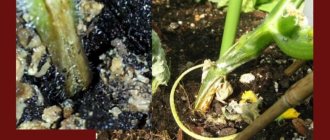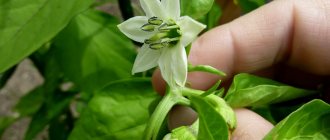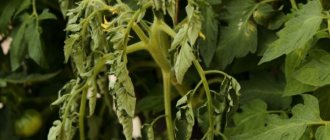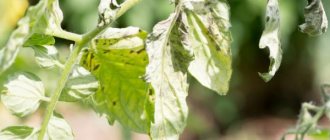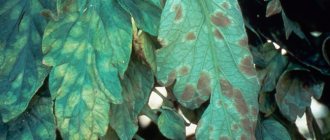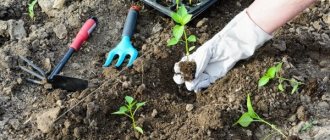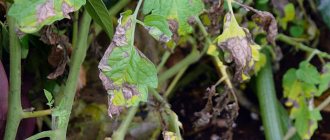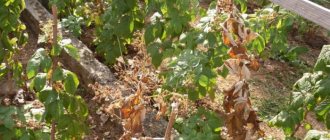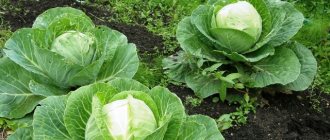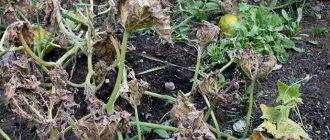Summer gardeners want to grow as many different crops as possible on their plot, so that everything on the table is homemade, grown with love and with their own hands. Many of us ask a logical question: why do peppers rot in a greenhouse? After all, it is not exposed to direct sunlight, rain and wind. It is very sad that after hard work our plants begin to get sick. It seems that everything has been done correctly: the greenhouse has been set up and watering is regular, but the crops are dying. Let's look at this issue in more detail.
What conditions are needed for the growth of sweet peppers?
Conditions necessary for normal growth and development of sweet pepper bushes:
- loose light soil;
- air humidity not higher than 60%;
- watering as the top layer of soil dries;
- proper fertilizer;
- ventilation mode;
- soil temperature within 25 degrees.
These five points are the basis for a good pepper harvest.
Pests
Due to disturbances in the microclimate in the greenhouse, the plant’s immunity weakens. It becomes difficult for him to resist pests and diseases. Therefore, you should not neglect the recommended parameters of air humidity and temperature inside the greenhouse, as well as ventilation.
Pepper is susceptible to attack by pests such as:
- aphid;
- spider mites;
- slugs;
- wireworm;
- May beetle larvae.
As a result of their activity on the plant, the fruits rot and become covered with dark spots. To prevent the spread of pests, the soil is disinfected. This is done with boiling water or iodine solution.
If the pests have already settled in the greenhouse, then they are treated with insecticides. They use Actellik or other drugs that help fight uninvited guests. Gentle folk methods involve spraying with a solution made from onion peels or garlic.
Diseases of bell peppers
Diseases in bell peppers can be caused by violations of one or more growing conditions. For example, elevated temperatures or humidity, unbalanced fertilizing, poor-quality heavy soil or lack of ventilation. Let's look at some of the main types of pepper diseases:
- Apex rot.
- Late blight.
- Blackleg.
- Spotted wilt.
- Gray rot.
Apical rot
If brown spots appear on the pepper, then this is the beginning of the disease with blossom end rot. It is manifested by the appearance of dark brown spots on the tops of the fruits, which grow. These spots are dry to the touch. As the disease progresses, the spots become larger and flat or depressed areas of dry rot appear. Affected vegetables stop growing and ripen quickly. Fruits that have been affected by blossom end rot should not be eaten, as they have a bad taste and will not bring any benefit.
Some recommendations:
When studying blossom end rot, it was revealed that in 90% of cases of this disease, the cause is irregular watering at elevated temperatures. The regularity of soil moisture, temperature and air humidity should be optimal (temperature 18-22 degrees, humidity 60%). When air temperatures rise, watering should be increased and vice versa. Ventilation of peppers in the greenhouse also plays an important role.
See also
65 best and most popular pepper varieties in 2021 with descriptionsRead
The main causes of fruit rotting and ways to combat the disease
The appearance of rot on sweet pepper fruits in a greenhouse can be caused by a number of reasons:
- Fungal or bacterial diseases.
- Sudden temperature change.
- Systematic watering with cold water.
- Poor, uneven lighting.
- Excess organic fertilizers.
- Gross errors in agricultural technology and plant care system.
Pepper crops love warmth, light and abundant watering, but do not tolerate drafts and excess humidity
Maintaining a balance of humidity and temperature and “not catching a cold” is important for the pepper, otherwise the plants’ immunity drops and they become vulnerable to various diseases.
Traditional methods of treating blossom end rot
What to do if blossom end rot starts on sweet peppers:
- One liter of milk is poured into a bucket and topped up with water to 10 liters. This solution is applied to the leaves and fruits of pepper once a week. Repeat the procedure 2-3 times.
- Dried eggshells crushed in a mortar are also used. It is crushed into powder, which is sprinkled on the holes before planting seedlings in them.
- Two tablespoons of chalk crushed into powder are mixed with one liter of warm water and watered on the affected bush.
However, it must be remembered that excess calcium content can lead to a lack of potassium in vegetables, and this can lead to problems with fruit ripening. Therefore, an integrated approach and moderation in soil fertilization are necessary.
Late blight
A common disease of peppers is late blight. To the question: why do pepper fruits turn black, we can definitely say that this is due to the penetration of the late blight fungus into the cells of the vegetable. The onset of the disease is characterized by the appearance of small dirty green spots on the fruit. Then these spots become large and black spots and spoil the entire bush. The leaves of the plant bush become twisted, as if they were burnt. The plant dies. And fungal spores are spread to neighboring plants and enter the soil.
Prevention
Bacterial and fungal infections are very difficult to treat. If plant damage is only observed, then special chemicals are used for therapy. If the damage is severe, the crop, as a rule, cannot be saved.
To prevent the development of diseases dangerous to plants, it is necessary to adhere to the following preventive measures:
- Before sowing, it is necessary to disinfect the seeds collected by hand. To do this, the seeds are soaked in a slightly pink solution of potassium permanganate for 3 hours. Purchased seeds (in bags) do not require such treatment.
- If last year the plants already showed signs of blackening of the leaves, then before making fresh sowings it is necessary to disinfect the soil. To do this, the top layer of soil (about 50 cm) is removed, and fresh soil is poured in its place. Before pouring fresh soil onto a bed or into a greenhouse, it is recommended to disinfect it: thoroughly pour boiling water over it or harden it in the oven.
- If a plant affected by the disease is discovered, it must be urgently dug up and destroyed. The soil in which the diseased plant grew is disinfected with a solution of potassium permanganate.
- Remove weeds and plant debris from the beds in a timely manner, and prevent plants from rotting on the soil surface.
- Before starting spring work, it is necessary to disinfect all garden tools. You can also use a solution of potassium permanganate for this. Appropriate processing must also be carried out for the boxes in which the seedlings will be planted.
- Avoid watering peppers with cold water. Supercooled soil is a favorable habitat for pathogenic microorganisms. Watering heat-loving plants is carried out only with warm liquid.
- Pathogens of fungal, viral and bacterial infections actively multiply in acidic and slightly acidic soils. Peppers prefer to grow in neutral soil. In order not to provoke the development of pathogenic microorganisms in the spring, it is recommended to alkalize the soil. To do this, use slaked lime, dolomite flour or fine ash.
- Experienced gardeners do not recommend planting pepper seedlings in peat pots, since it is peat that increases the acidity in the soil.
- Follow the basic rules of crop rotation. Peppers cannot be planted in one place for 2 or more years in a row. Good predecessors for peppers are beans, pumpkin, cabbage, carrots, peas, and beets. It is not advisable to plant peppers on ridges where eggplants, tomatoes or potatoes previously grew.
- Regularly loosen the soil around the peppers, this will help avoid waterlogging of the soil and prevent the leaves from turning black.
- Do not plant pepper seedlings close to each other.
- Ventilate the greenhouse regularly, especially in hot weather. Ventilation is carried out during the daytime. Greenhouse doors should not be opened at night.
Recommendations for disease prevention
Peppers are treated for late blight using special chemicals. And prevention is carried out with a solution of Bordeaux mixture, also by spraying with Fitosporin-M, calcium nitrate, etc. Ventilation in greenhouses and watering the bushes with warm water also play a very important role.
Blackleg
Blackleg usually affects pepper seedlings. But it can also affect fruits when its spots appear on the fruits. It is characterized by the fact that on the bush, closer to the root, a dark gray or black area of necrosis appears. Then the root rots and the plant dies. Infection with black leg on pepper can be prevented if the seeds are soaked in a solution of potassium permanganate and the seedlings are watered with a warm, weak solution of potassium permanganate. The natural antifungal drug Fitosporin also works very well. However, if the stems turn black, then such plants are urgently removed from the site and burned.
See also
Is it possible to spray pepper with boric acid for the ovary and how to prepare the solutionRead
Spotted wilt
The answer to the question: why do peppers rot on bushes in a greenhouse may be that the plant has suffered from spotted wilt. This disease begins with dark yellow or brownish spots appearing on the leaves. They are similar to sunburn, so the appearance of dark ring-like dryness on the leaves and fruits of peppers is often confused with them.
The reason for the appearance of bronze is that this disease is transmitted by insects: aphids, cicadas, thrips. If insects appear on the plants, they must be treated with appropriate insecticides, and the plant must be treated with Fundazol.
Gray rot
Gray rot of peppers develops when the plant is exposed to conditions of very high humidity and heat. It affects all parts of the plant. The stem, as well as the leaves, fruits and flowers of the plant can rot. Decay is promoted by the proliferation of gray mold fungi. If the greenhouse air is very humid, the disease will spread to a large area of peppers very quickly. This could cause the entire crop to perish.
If sweet pepper grows outside, in a garden bed, then never plant it under trees and shrubs. Gray rot can appear after prolonged rains or with insufficient air aeration. This can happen if the peppers are planted too thickly or there is poor ventilation in the greenhouse.
Adviсe:
- Treatment for gray rot should be carried out immediately after its first signs are discovered. Treat the bushes after removing the affected areas of the plant and fruits with a fungicide solution.
Prevention from the disease is important. It consists of maintaining soil and air humidity levels.
Why does pepper rot on the bush and what to do in the greenhouse and open ground to save the harvest?
Peppers are a southern plant and difficult to grow in cool climates. Even in greenhouses, problems associated with fruit rotting are possible. Sometimes the cause is direct non-compliance with temperature and humidity conditions, but more often the diseases arising from this are to blame.
Why does the pepper rot on the bush?
Pepper is not only a heat-loving crop, it requires a lot of work from the gardener aimed at creating the following conditions:
- sufficient illumination of the bushes;
- constant but moderate soil moisture;
- relatively dry air;
- a wide variety of nutrients.
At the slightest violation of the necessary conditions, the plants weaken and easily contract various diseases. And if in open ground it is most difficult to provide sufficient heat, then in a greenhouse diseases are often associated with too humid air. In general, there are few main causes of rotting:
- prolonged drop in air temperature below 15 °C;
- poor ventilation of the greenhouse during dense plantings;
- soil unsuitable for peppers;
- too much irrigation water, especially cold water;
- mechanical damage (accidentally caused by the owner or pests such as slugs).
As a result of these reasons, fruit rot is already possible, but they often cause diseases, such as:
- late blight;
- Alternaria blight;
- anthracnose;
- top rot;
- gray rot.
In any case, urgent correction of agricultural technology, elimination of the causes of rot and treatment of emerging diseases is necessary.
Methods to combat the problem and save the harvest
To prevent fruit rotting, you should take basic measures: destroy weeds, immediately remove diseased plants, do not overwater the beds, and loosen them in a timely manner. Peppers in hot weather (above 30 ° C) can rot simply due to improper watering (cold water on the foliage).
In this case, the diseased fruits must be destroyed; after normalization of watering, if the plants did not get sick, everything will return to normal. If diseases occur, if the outbreak is small, you will have to treat the bushes with one or another preparation.
However, it must be taken into account that if there are only 2-3 weeks left before harvest, chemicals cannot be used.
Late blight
The first signs of the disease are the appearance of dark spots on the leaves, then blackening of the leaves and stems, and rotting of the fruits. Diseased specimens must be immediately destroyed. If the foci of the disease are small, tear off the affected areas (leaves, shoots) and burn them.
When late blight is advanced, both the crop and the bushes themselves die
The bushes must be immediately treated with a solution of Bordeaux mixture or Fitosporin. In the case of Bordeaux mixture, prepare its 1% solution according to the instructions on the package. Fitosporin is available in both powder and liquid form. The powder is taken in a dose of 5 g per 10 liters of water, the liquid is first diluted three times, after which 1.5 tbsp is taken per bucket of water. spoons of the resulting concentrated solution.
Both solutions are used immediately after preparation, spraying the plants with them. Among folk remedies, garlic tincture with the addition of potassium permanganate is effective (take 2-3 heads of chopped garlic per bucket of water, after 2-3 days add 1 g of potassium permanganate).
After the end of the season, the bed is dug well, spilled with a 1% solution of copper sulfate, and the walls and all buildings in the greenhouse are disinfected.
Alternaria and anthracnose
Alternaria is a fungal disease that sometimes appears early, but usually attacks in the second half of summer, especially with fluctuating temperatures and high humidity.
Watery, angular spots appear on the leaves, quickly turning brown or almost black in color. On the fruits, large dark spots appear closer to the stalk, then in other places, after which they rot and mummify.
The disease progresses in dry weather and most often manifests itself in open ground.
Alternaria blight is also called dry rot.
The treatment is not easy; Quadris or Polyram, as well as various copper preparations (for example, Bordeaux mixture or copper oxychloride) can help. Several applications may be required, but the last one should be carried out no later than three weeks before harvest.
Anthracnose manifests itself in a similar way, but usually already on ripening fruits. Treatment is the same as in the case of Alternaria.
Apical rot
This non-infectious disease occurs when improper watering is combined with temperature fluctuations, especially against the background of an excess of nitrogen and a lack of calcium.
Dark-colored spots appear on the tops of unripe fruits, this provokes their premature ripening, but ripened-looking peppers are tasteless and dry out right on the bushes.
To prevent this from happening, watering should be carried out only with warm water at the root, without waterlogging the soil.
Top rot always begins at the crown, but then affects the entire fruit.
The disease is treated by spraying the bushes with lime milk (200–300 g of freshly slaked lime is diluted in 10 liters of water, the bushes are sprayed 2 times at weekly intervals). Instead, you can take a solution of calcium nitrate (1 tablespoon per bucket of water), and you will also have to repeat the spraying after a week. Wood ash, scattered under the bushes in a thin layer, also works well.
Gray rot
In conditions of high humidity and high temperatures, this disease affects the entire bush. The beginning is the formation of dark spots on the fruits, then both the fruits and leaves rot, and the rotting spreads to the stems. The spots are covered with a fluffy gray coating.
Like most fungal diseases, gray mold is treated with various fungicides, starting with Bordeaux mixture. Fundazol or Skor are also used strictly according to the instructions.
If you do not want to use chemicals, you can treat with a chalk solution (2 tablespoons of chalk powder per 1 liter of water) or a solution of milk in water (1:10).
Garlic tincture also helps a lot (take several heads of chopped garlic per 10 liters of water and leave for 2-3 days).
Rotting of peppers in the garden happens often and is always associated with unfavorable conditions or improper agricultural practices. If the matter has gone far and a disease has appeared, you can try to cure it, but you must remember that eating the fruits is possible only a few weeks after treating the bushes with chemicals.
Source: https://dacha.help/ovoshchi/pochemu-gniet-perets-na-kustu
